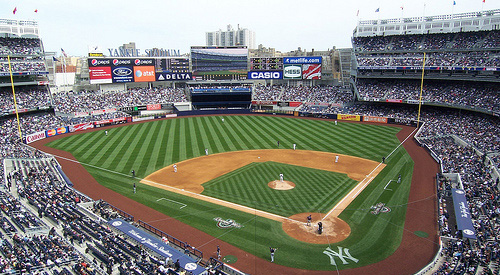
MLB castles fit for their kings
Some citizens always keep their pitchforks at the ready.
Every time a new stadium is proposed, funded by public money, otherwise apathetic men and women rise up with riotous indignation, protesting that the money would be better off spent on schools and hospitals and other institutions founded for the public good. (These folks are rarely heard from the other 99 percent of the time. Schools and hospitals deserve only ballpark money, apparently, and no more than that.)
Similarly, every time a new contract is signed, handing over $100 million to the latest impact kid to hit the sporting landscape, folks work themselves into a hot rage about the amount of American dollars being paid to hit a ball with a stick when it should be going to teachers and nurses and underappreciated professionals who are doing real honest good in this world.
I’ll stand with the first group of outraged citizenry – but not the second.
Call me crazy if you’d like. Given the choice between revitalizing a downtown area and handing millions of dollars to a boy hitting a ball with a stick, I choose the latter.
New stadiums really do benefit a community; I’ve witnessed it firsthand. Jobs are most certainly provided, the economy around the stadium is positively affected, and new businesses are likely to arise from the increased flow of people through the area. Within a short span of time, a stadium might just produce a renaissance in a formerly depressed neighborhood, allowing all of the stadium’s supporters to jubilantly gloat in the faces of the most outspoken naysayers. It’s a wonderful thing to be proven right.
[php snippet=1]
The problem comes in the long term.
The expense that it takes to build a stadium doesn’t just come to an end once the facility has been erected. Each year, new resources are required for upkeep, food and beverage, and maintenance of every possible detail that might – and will – break down. It’s not enough, too, to keep everything as is. Fans want and expect their ballparks to provide something new and fantastic each year; otherwise, it’s as if ownership is just resting on its laurels and hoping that the fresh appeal of the inaugural season doesn’t fade.
Stadiums, like computers, cell phones and television sets, go obsolete in a hurry. New ballparks perpetually open their gates with the newest in luxuries and enhancements to draw upon fans’ interests, making the older parks look a little more outdated with each passing season. The monster video board is no longer big enough; the sound system is no longer top quality.
The initial draw of the new stadium experience is now gone. It’s just an ordinary ballpark now, but without any of the charm of an historic field. If the home team is mediocre, there’s no reason for fans to continue to fill the seats. And the stadium continues to burn through money…
I just don’t see it. Five to 15 years of local renaissance isn’t enough for me. Let the ownership pay for the ballpark itself.
Now to the ballplaying kid – the one getting paid more for eight months than you’ll ever make in your lifetime; the one who could, if he wanted, dive around in a pool of his money like Scrooge McDuck.
Willie Mays once said, “They throw it, I hit it. They hit it, I catch it.” And, yes, baseball can be boiled down simply to its on-field mechanisms – if, that is, you’re merely trying to explain it to a second grader. (You could also describe rocket science, if you so chose, as “Build a rocket, launch it, learn about our universe.” Simple stuff.)
I simply wonder this: How much money does a star baseball player make for everyone else? How much do TV networks like ESPN, or clothing manufacturers like Nike profit because of widespread interest in star athletes? How many jobs are spawned and subsidized, houses built, and families supported because Albert Pujols or Alex Rodriguez or Derek Jeter can hit a baseball?
On a different tact, if you’re the owner of a Major League Baseball team and you know that signing a superstar athlete will cause fans to run to their phones or computers to purchase thousands of season ticket packages and closets filled with that player’s name and number printed on replica jerseys – why wouldn’t you reach for the checkbook? All you’re doing, after all, is handing the player a small percentage of the money that you’re going to make off his name and image.
No, it does not help the ballplayer’s cause that we know exactly what salary he’s bringing in. Those millions are as associated with his name as his batting average, after all. But it most certainly sounds reasonable to me that a player should be entitled to at least a small portion of the wealth he helps his employer accrue. (I believe the finest in private schools do in fact pay their teachers in a similar fashion.)
It’s true, a star player will consistently wear out quicker than a stadium, but it’s far easier to replace the player than the stadium – and the expenses are far less.
Or you could simply keep your pitchfork sharpened.
[php snippet=1]

